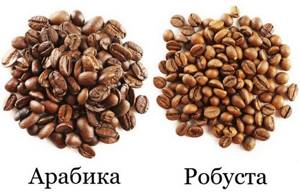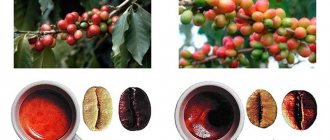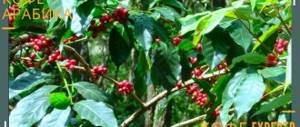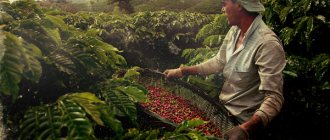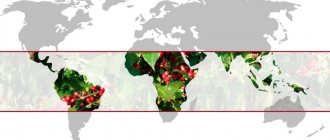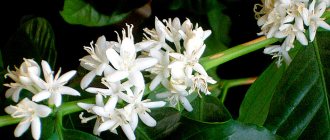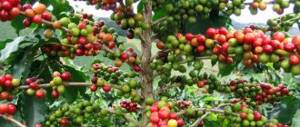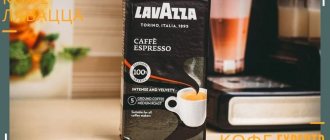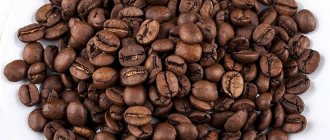General information about the coffee tree
Congo tree, or robusta, is a plant native to Africa and the equatorial forests of Asia.
The main feature of this variety is its strong taste. The name is translated from one of the African languages as “strong”.
Origin story
Due to the fact that robusta beans originate from the Congo River Basin in Uganda, where the rugged plants were first discovered in 1830, this variety is also called Congolese coffee. The drink made from such raw materials was bitter, which negatively affected sales, because... European and American coffee drinkers preferred softer Arabica beans.
However, at the end of the 19th century. Its main plantations suffered from leaf rust and were completely destroyed. Then planters turned their attention to robusta because of its disease resistance and high yield. Trees were exported from Africa to other parts of the world, where they quickly took root.
The 1954 frosts in Brazil, which destroyed Arabica plantations, forced the government to allow farmers to grow a hitherto unusual variety. Then the largest manufacturers of ground coffee began to add such beans to their products. In Italy they found that 10-15% robusta increases the tonic properties of espresso and gives it a chocolate taste.
Places of growth
Wild coffee trees from the Congo grow up to 10 m in height. On plantations they are pruned to form a bush crown. They require a humid climate with an average annual temperature of +22…+26 °C.
The plant is not picky and has no special requirements for soil composition, climate, or location of the site.
The largest suppliers of the London Coffee Exchange are:
- Guatemala, where Robusta is grown together with Arabica. To increase the yield, owners graft cuttings of the second variety onto the stem of the first variety.
- Liberia has fertile soil and suitable climatic conditions. The grains supplied from here are characterized by a special aroma and increased strength and amount of caffeine in the drink made from them.
- Tanzania, where Robusta is not the dominant crop. However, coffee from these places has a deep taste and a slight pleasant sourness.
- Angola, which before the civil war was one of the five largest exporters of the Congolese variety. Now production is quickly recovering. The finished drink has a chocolate-sour taste and a high caffeine content.
- Vietnam is the largest supplier of robusta. Its plantations occupy about 90% of the coffee plantings in the country.
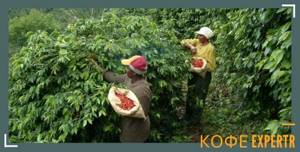
India, Ecuador, Cote d'Ivoire, Madagascar, and Indonesia also became major producers. Cultivation of the crop is prohibited in Colombia and Costa Rica.
Compound
Classic Congolese coffee includes:
- caffeine;
- amino acids;
- minerals;
- vitamins;
- sucrose;
- aroma oils;
- cellulose;
- organic acids.
What affects quality
Arabica plantations still suffer from leaf rust, and farmers have to become more sophisticated. They cultivate Robusta using different technologies to achieve the best taste.
Baristas are against this variety. They believe that it does not have such harmonious taste qualities as Arabica. In fact, everything is not so bad. The quality of robusta depends on the climate and conditions under which the coffee was grown.
Interesting! Is it possible to grind coffee in a blender?
In poor countries like India and Indonesia, coffee is grown without meeting all technological requirements. Coffee trees are poorly cared for. And they can dry grains on old mats or wooden platforms, which are almost never washed. The grains absorb the smell of grass and earth. This spoils the taste of the coffee.
In Vietnam, robusta is grown by small farmers who harvest the entire crop at once, including unripe grains. This leads to a large number of defects and deterioration in quality. Today this problem is being solved at the state level.
To obtain an acceptable taste of the coffee blend, manufacturers prefer wet-processed Robusta. It allows you to get rid of the unpleasant smell of dried grains.
Description of Robusta
This variety has its own characteristics.
Bean shape
It is round and large in size. There are varieties with grains twice as large as Arabica beans.
Taste characteristics
A drink made from the Congolese variety in its pure form is characterized by the following features:
- pungent, rough taste, which is why it was not immediately accepted in Europe;
- slight bitterness;
- high caffeine content - 100 ml contains the recommended daily dose;
- wateriness of the finished product.
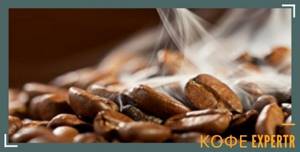
Robusta has a specific aroma that is not to everyone's taste.
How is Robusta used?
Despite the visible shortcomings, Robusta ranks second in production. More often it is added in small quantities to the mixture with Arabica, but there are exceptions. It is mainly used in the following cases:
- as espresso blends;
- in its pure form;
- for making instant coffee or with flavors.
It adds strength and bitterness to espresso. Also, similar compositions are suitable for cappuccino and latte. Due to the large amount of milk, the taste of coffee may be lost, so Robusta in this case corrects the taste. Vending coffee machines use mixtures or single varieties.

Coffee with 100% robusta is preferred by some coffee lovers because of its strength and bitterness.
Even if the packaging of an instant drink says that it is 100% Arabica, then in many cases it is Robusta. It is cheaper and in soluble form tastes similar to the declared variety. Therefore, manufacturers resort to cunning.
Flavored ground or instant coffee is almost always this too. It's not just about saving. It makes no sense to flavor Arabica, because it itself has a pleasant, expressive aroma.
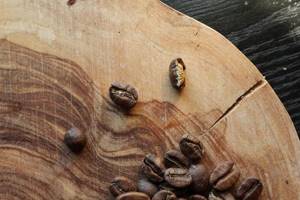
Varietal varieties and hybrids
The most popular varieties were:
- Indonesian Java Katakan, classified as a specialty, with light sourness and nutty, licorice, malt notes;
- Angolan Ambry with a sweetish earthy flavor;
- dense and aromatic Brazilian Conillon;
- spicy-sweet Indian Bali Shinzan with clove notes and aromas of persimmon and pepper from Jamaica;
- citrus alpine Catura from Brazil;
- rare and expensive Latin American or Ethiopian Typica;
- Brazilian Bourbon Santos, collected from trees no older than 3 years;
- bitterish, with a taste of chocolate and spices Plantation A from India;
- fragrant Venezuelan Caracas;
- Indonesian Java Ineak;
- Quilu from Congo with maximum caffeine content;
- soft Blue Dragon and Sang Tao 1 from Vietnam.
Among the hybrids it is necessary to highlight:
- Hybrido de Timor - a mixture of Arabica and Robusta from the island of the same name;
- Mundo Novo, obtained by crossing the Typica and Bourbon varieties;
- Maragogipe is a low-yielding and expensive coffee from the Brazilian province of Bahia.
Robusta varieties
Common varieties include the following:
- Ambry - grows in Angola, hence the most expensive varieties of this coffee;
- Conillon - grown in Brazil, has a strawberry flavor;
- Quilu - grows in the Congo and is used in expensive mixtures. It has a pronounced bitterness, which is partially eliminated during frying;
- Indonesian Java Ineak.

Beneficial properties for the human body
Most often, robusta is included in instant coffee varieties. Increased caffeine content gives energy and helps prevent diseases such as cancer, diabetes, bronchial asthma, cirrhosis of the liver and disorders of the genitourinary system. The drink has an antioxidant and tonic effect.
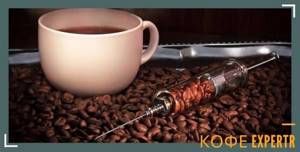
Robusta is a good energy drink due to its high caffeine content.
What is Robusta
Congo tree, or robusta, is a plant, a tree native to Africa and the equatorial forests of Asia. It is believed that it was first discovered in Uganda in 1830, and was found in the Congo River basin. The name Robusta means “strong”. This is explained by the fact that the tree Coffea canephora (genus Coffee, Madder family) is able to survive in conditions unsuitable for the growth of Arabian coffee.
There are a great variety of coffee trees in nature, so it is very difficult to classify them. There are more than 80 species of trees, their fruits are called “coffee”. Plants can be both dwarf and very tall: in natural conditions their height reaches 10 meters. To make it easier to collect fruits, trees are pruned. The plant is resistant to disease, produces a good harvest, is easy to care for, and durable. The most common are Coffea Arabica (Arabica) and Coffea Canephora (Robusta).
The shrub, whose height is 2-3 meters, is a vigorous, pubescent, evergreen crop. The root shaft is short, the bulk of the root processes are concentrated on the top layer of soil, a depth of no more than 15 centimeters. The branches are vertical and horizontal (fruiting), and fall off after dying. The leaves have a wavy shape with smooth edges, each length is from 5 to 32 cm, width – 2-8 cm. They are located on short petioles, drooping. The flowers are white, 3-6 inflorescences each, with a creamy-brown star in the middle. They have a fragrant aroma and are pollinated by the wind.
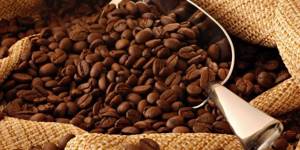
The fruit is a round berry. When mature, it is 0.8-1.5 cm long and dark red in color. Externally, the grain is covered with a strong skin (exocarp), under which there is a thin pulp (mesocarp). The seeds are paired, oval, flat-convex, with a deep groove on one side, surrounded by a gray-green thick parchment shell. Fruits appear at the age of 2.5-3 years.
At the end of the 19th century, Congolese coffee was actively grown on plantations in Uganda, where up to 15 harvests were collected per year. After all Arabica plantations were devastated by the plant disease leaf rust, in 1900 a new variety of tree was brought to Java from the Congo. Coffee is one of the main economic crops in most tropical countries. Today, the largest areas for growing robusta are located in Vietnam. Robusta accounts for 30% of the world's coffee production.
The quality of robusta is an order of magnitude lower than that of Arabica, but the strength is higher and it contains more caffeine. The variety is often included in espresso and instant coffee mixtures. A rich drink is obtained by using mixes that add strength and a specific bitterness. The most common percentage is 80% Arabica and 20% Robusta.
Professional baristas use one trick: they mix two types of coffee. This makes an excellent raw material for a tasty drink, especially since there are very few lovers of pure robusta. According to experts, love for it is explained by the need to consume a large dose of caffeine, and not by taste preference. Green Robusta beans are specially processed to soften the astringent taste and bitterness.
The largest warehouses of Robusta coffee beans are located in London, from where this product is distributed throughout the world. Modern farms carry out breeding work, breeding new species with less caffeine and improved taste. The London Coffee Exchange is actively trading this variety. The weight of coffee is a ton, and the monetary unit used in calculations is the British pound sterling.
- How to treat prostate adenoma and prostatitis
- Chicken legs with potatoes in the oven: recipes
- Beef baked in the oven: recipes
Kinds
Robusta has several varieties. The most common types of coffee tree are ambri, conillon, and quilu. Their features are as follows:
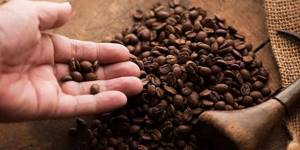
- Ambry. Common in Angola, where the most expensive varieties are grown.
- Conillon du Brazil has a distinct strawberry flavor. Homeland - Brazil.
- Quilu. Homeland: Congo. It has high taste characteristics and is used in the preparation of expensive varieties of coffee. The grain consists of 4% caffeine, 9% essential oil, an alkaloid substance (gives a bitter taste). After roasting, the bitterness partially goes away.
Features of application
Robusta accounts for about 30% of the coffee market. It is used in the following cases:
- For adding strength, bitterness and creating a creamy base in espresso blends. When adding milk, the taste is not lost in either latte or cappuccino. When refilling vending machines, pure Congolese coffee or a mix with its predominance is often used.
- Those who love a strong drink prefer single-origin. There are many such buyers in Russia.
- For the preparation of flavored and instant varieties. In these cases, bags and jars contain larger quantities of Robusta.
Rules for roasting beans
First, the coffee cherries are picked and sorted by hand. The pulp is then removed and dried before frying. The main rule is that the process continues until the second clap. The more the grain is processed, the brighter the taste qualities appear, and the brighter the aromas of the oils that make up the raw material are revealed. Several degrees of preparation of Congolese coffee are known:
- light brown Scandinavian;
- milk chocolate Viennese;
- dark French;
- almost black Italian.
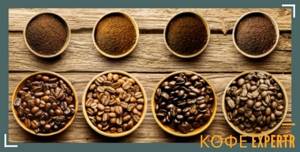
There are 4 degrees of roasting of Robusta.
Criteria for choosing Robusta coffee
First, you should determine which flavor is preferable to purchase and select the desired variety and roast.
Preference should be given to ground varieties, because... they preserve the taste and aroma characteristics of the drink.
How to spot a fake
Coffee, which has become a popular product in many countries, is often counterfeited. The main way to obtain counterfeit goods is to replace an expensive Robusta variety with a cheap one. Only a specialist can recognize such a fake.
The second method of making a surrogate was the addition of impurities:
- starch;
- acorns;
- beans;
- barley;
- clay, etc.
You can distinguish counterfeits visually by determining the absence of color inclusions in the powder or by detecting the shell when the grain is broken.
Several factors should also alert the buyer:
- low-quality, sloppy or non-standard packaging;
- unusual taste;
- color uncharacteristic for the variety;
- lack of information about the contents and manufacturer on the package or jar.
A reliable way to protect yourself from buying counterfeit coffee is to get into the habit of purchasing coffee from trusted retail outlets and specialized stores.
Approximate cost
Although Robusta is cheaper than Arabica, its price cannot be lower than average. For different varieties they are approximately as follows:
- coffee from Uganda costs about 110 rubles. per 100 g;
- Indian Kaapi - 120 rub. for the same packaging;
- Vietnamese Typika - from 200 rub. for a similar bag;
- Brazilian Santos cannot be cheaper than 200 rubles. for 150 g;
- Blue Dragon — 230 rub. for 250 g;
- Me Trang from Vietnam - 450 rubles. for half a kilo.
Large packages of 1 kg do not cost more than 1 thousand rubles:
- Noir (Netherlands) - 750 rubles;
- Lavazza Gusto Forte (Italy) - 800 rubles;
- Lavazza Espresso Vending Gusto Forte (Italy) - 830 rubles;
- Bourbon Intenso (Italy) — 950 rub.
Arabica or Robusta?
There are more than 40 types of coffee trees in nature, but only two are mainly used for coffee production - Arabica and Robusta. Moreover, the difference between Robusta and Arabica is great, from the chemical composition to the cultivation conditions. So what is the difference between these two types of coffee?
First of all, you need to distinguish between concepts such as “type of coffee” and type of coffee.” It would be incorrect to call Arabica and Robusta, as well as less common types of coffee - Liberica and Excelsa, coffee varieties. These are all species of the coffee tree, each of which has a certain number of varieties used for the commercial production of the popular drink.
There are 9 main differences between Arabica and Robusta:
- Coffee bean shape. Arabica beans have an elongated oval shape. Robusta beans are typically smaller than Arabica beans and have a more rounded shape.
- Cultivation conditions. Both types of coffee require different growing conditions. So Arabica is grown much higher than Robusta - this is from 600 to 2200 meters above sea level, and Robusta grows up to 800 meters above sea level. In addition, robusta requires a more humid and warm climate. For example, comfortable climatic conditions for robusta are 18-36 degrees Celsius, with an annual precipitation of 2000-3000 mm, while Arabica is less demanding - 15-24 degrees Celsius, with 1200-2000 mm of precipitation per year, respectively.
- Coffee tree size. The height of the Arabica tree is shorter than that of the Robusta tree. Arabica can reach a height of up to 4.5 meters, in contrast to the Robusta tree, which can grow up to 6 meters.
- Genetic differences. Arabica has 44 chromosomes, versus 22 in Robusta.
- Chemical composition of coffee beans. Robusta contains twice as much caffeine as Arabica, which directly affects the tonic properties of the drink. However, due to the lower content of sucrose and higher amounts of chlorogenic acid compared to Arabica, Robusta coffee cannot boast of good taste and aroma. Most often, Robusta is used as an additive to Arabica to increase the caffeine content in a mixture of these two types of coffee.
- Difficulty in growing a tree. Robusta wood is less demanding to care for than Arabica wood. With lower cultivation costs compared to Arabica, Robusta produces a larger grain yield that is less susceptible to disease and damage by insects due to the high content of caffeine and chlorogenic acid.
- Price. Due to lower cultivation costs, the price of Robusta grain is almost two times lower than Arabica grain. True, the organoleptic qualities are also two times lower than Arabica.
- Arabica and Robusta flavours. As noted earlier, the taste qualities of both types of coffee come from the chemical composition of the bean. Roasted Robusta is more bitter, due to the high content of caffeine and chlorogenic acid, which is not present in Arabica, which has a characteristic sourness and aroma due to the higher amount of sucrose and lipids than in Robusta. The taste of a drink made from pure Robusta can be described as “rough” without any shades or nuances, unlike Arabica, which can have many shades of taste and aroma, depending on the variety and processing conditions.
- Use of Robusta and Arabica. As a rule, Robusta is used in mixtures with Arabica in various proportions to increase the proportion of caffeine and also reduce the cost of the finished product. In addition, large quantities of Robusta beans are used to make instant coffee. If you regularly drink inexpensive instant coffee, then you can confidently say that it is made with a maximum proportion of robusta and a minimum of Arabica.
Thus, we can summarize that if you drink coffee only as a tonic drink, then your choice is Robusta. However, if you are a connoisseur of the noble taste and aroma of an ancient drink, then you will not find anything better than pure Arabica varieties.
Methods for preparing the drink
There are several types of robusta drink. The easiest way is to prepare the 2 most interesting of them.
Glyase
Glace has many fans in many countries around the world. To prepare it you need:
- ice cream;
- syrup;
- chilled whipping cream;
- coffee prepared in a Turk or coffee machine;
- chilled whipped cream.
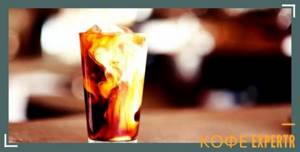
The ingredients are added in this order to special containers.
Oflameron
The cooking procedure is as follows:
- Grind the grains.
- Pour into a metal glass.
- Heat 60 g of water.
- Add it to your coffee.
- Place the container on low heat and wait for foam to form.
- Pour in 2 tablespoons of still champagne.
- If foaming occurs rapidly, remove from heat.
Storage nuances
In order for Congolese coffee varieties to protect their taste and aroma, several rules must be followed when storing them:
- keep the packaging tightly closed in a place protected from direct sunlight;
- Do not place the jar or bag next to foods that have a strong or pungent odor.
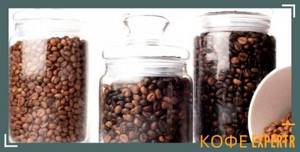
It is recommended to store Robusta in a closed glass container.
Fundamental differences between Robusta and Arabica
The two varieties have a lot in common, but there are also differences:
- Place of origin. Robusta originated in Congo and Uganda, and Arabica originated in Ethiopia.
- The height of plants in the first variety is up to 10 m, and in the second - no more than 4.5 m.
- The gene code of a stronger coffee variety contains 22 chromosomes, while a soft Arabica coffee contains 44.
- The Robusta inflorescence is large and lush, unlike the Ethiopian species. The leaves, on the contrary, are droopy and hard.
- The fruit ripening period for a plant from the Congo is 9-11 months, while for a competitor it is 6-8.
- Plantations of one variety are unpretentious to the terrain and love a humid climate, while the second variety prefers high mountain areas with a warm environment.
- Robusta is more disease resistant.
- Arabica requires cross-pollination, while Congo plants are self-pollinating.
- Robusta is processed using the dry method and the color of the grain is uneven, while its relative from Ethiopia is processed predominantly wet. The fruits become monochromatic.
- The taste of Congolese coffee is tart and bitter, astringent, while Ethiopian coffee is gentle and aromatic, dense and oily.
- Unlike Arabica, Robusta allows you to get a lush, creamy foam. It is called crema (with emphasis on the last syllable).
- In terms of caffeine content, the drink from Africa is superior - there it is 1.7-4%. The Arabian variety contains 0.8-1.5%. Chlorogenic acid in products is 9% and 6%, respectively.
Every type of coffee has its fans and detractors. You can find a compromise by buying a jar of high-quality mixture made from natural grains.
What is Arabica
The Arabian coffee tree, from which the popular Arabica beans are obtained, began to be cultivated on an industrial scale in the 14th century in Ethiopia. But wild trees still grow here. It's not even really a tree, but a shrub.
When free, this bush can reach up to 6 meters, but it is pruned to 2 meters to make it more convenient to pick berries.
Bush-trees of this variety are beautiful, but they require constant care. They require constant attention and adherence to temperature conditions. Plantations are usually located in the mountains at an altitude of 2000 meters. Read more about this type of coffee in the article “What is Arabica coffee.”
Interesting! Espresso coffee: what is it really?
